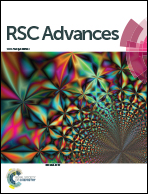A thiosemicarbazone based chemo and fluorogenic sensor for Zn2+ with CHEF and ESIPT behaviour: computational studies and cell imaging application†
Abstract
We report herein the development of a novel, diformyl-p-cresol (DFC)–thiosemicarbazide (TS) based sensor (DFC–TS) that selectively and sensitively recognizes Zn2+ by both UV-Vis and fluorescence methods. The gradual addition of Zn2+ to a solution of the ligand developed a new absorption band at 430 nm, while the bands at 370 and 316 nm gradually decrease generating one well defined isosbestic point at 390 nm exhibiting ∼17 fold turn-on fluorescent enhancement (FE). When we plot absorbance (at 430 nm) vs. [Zn2+] there is a gradual increase in absorption with [Zn2+], becoming saturated at ∼1 equivalent of Zn2+ and then again it increases with the increase in [Zn2+] and ultimately becomes saturated at ∼2 equivalents of added Zn2+. This clearly demonstrates that the Zn2+ binding event to the ligand occurs in two steps, one at a time. Non-linear least-squares computer-fitting of these data gives the parameters: K′f1 = (9.70 ± 5.51) × 105 M−1, n = (1.28 ± 0.05) for the first step and K′f2 = (1.11 ± 0.65) × 105 M−1 and n = (1.01 ± 0.06) for the second step. So far, this study provides the opportunity where we have successfully, for the first time, determined the stepwise formation constants; though they have values of the same order of magnitude. The ground state geometries of DFC–TS, both enol and keto forms and [Zn(DFC–TS)(OAc)], [Zn(DFC–TS)(OAc)]−, and [Zn2(DFC–TS)(OAc)2] were optimized using the Gaussian-03 suit program and bond distances of all species are in reasonable agreement with the reported values.


 Please wait while we load your content...
Please wait while we load your content...